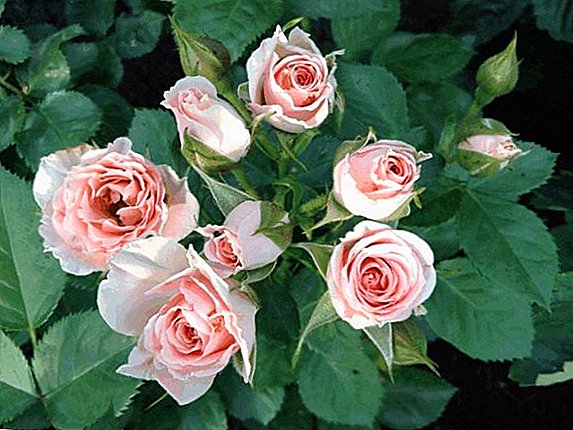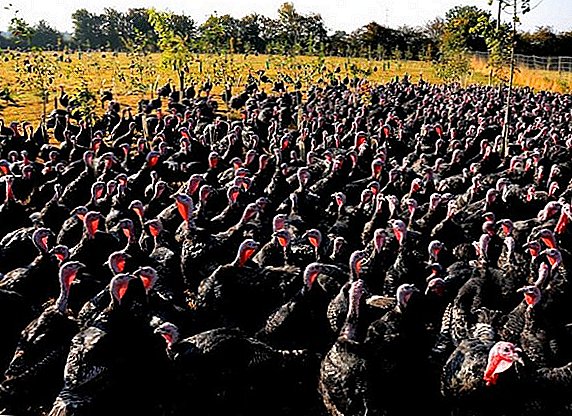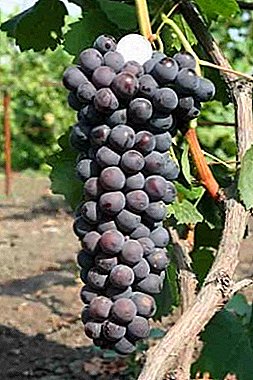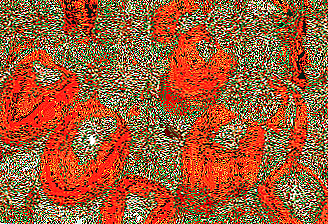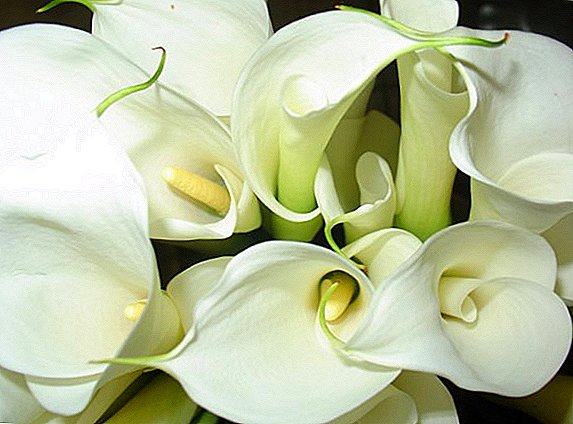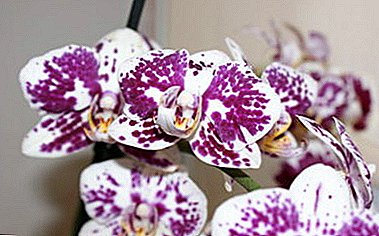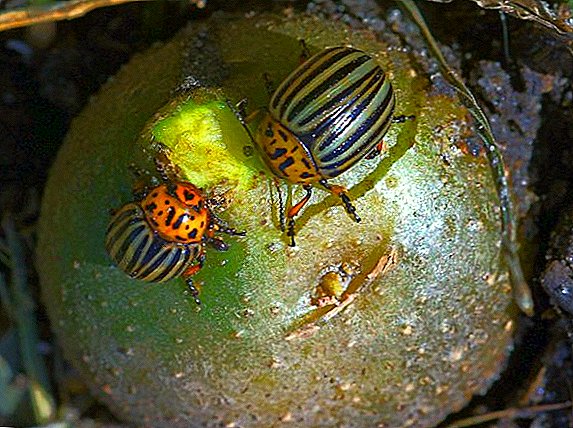 The Colorado potato beetle is a scourge of many summer cottages. Sometimes it is incredibly difficult to save potatoes from this pest. The insect adapts to pesticides, multiplies very quickly and in a matter of days, destroys the greens of the potato, thereby reducing its yield. Therefore, in this article we will talk about the Colorado potato beetle and the fight against it by folk remedies.
The Colorado potato beetle is a scourge of many summer cottages. Sometimes it is incredibly difficult to save potatoes from this pest. The insect adapts to pesticides, multiplies very quickly and in a matter of days, destroys the greens of the potato, thereby reducing its yield. Therefore, in this article we will talk about the Colorado potato beetle and the fight against it by folk remedies.
Characteristics and description of the Colorado potato beetle
 To begin, consider what the Colorado potato beetle is, when it was discovered and how it spread throughout the world.
To begin, consider what the Colorado potato beetle is, when it was discovered and how it spread throughout the world.
The pest was discovered by American naturalist Thomas Sai in 1824. The beetle got its name due to the fact that it devastated potato fields in the state of Colorado, however, Mexico is the birthplace of the beetle, where other subspecies of the Colorado potato beetle live that feed on tobacco leaves and solanaceous crops.
In Europe, the beetle spread during the First World War. The first country was France. The Colorado potato beetle moved east, and already in the 1940s it hit the territory of the USSR. The first foci were discovered in the Lviv region in 1949.
Colorado potato beetle (Leptinotarsa decemlineata) is an insect that belongs to the leaf beetle family. The pest parasitizes not only on potatoes, but also on all solanaceous crops: sweet pepper, eggplants, tomatoes, physalis and henbane.
Now about the fertility of beetles. The female of the Colorado potato beetle in its life lays about 500-700 eggs, which are arranged in groups of 30-40 pieces on the reverse side of the leaf. After two weeks, the larvae hatch from the eggs. This cycle takes up to 25 days.
Did you know? Some females can lay up to 2500 eggs, each of which will turn into a larva.
 To make it easier to assess at what stage the larva is, biologists have identified four ages. In the first and second instar the larvae are very small, sedentary. They keep in groups and feed on the substrate on which the eggs were located.
To make it easier to assess at what stage the larva is, biologists have identified four ages. In the first and second instar the larvae are very small, sedentary. They keep in groups and feed on the substrate on which the eggs were located.
At this stage, the parasites do not cause serious damage to crops, and it is easiest to collect them manually.
After molting, at the third and fourth stages of growth, the larvae disperse, often moving to other cultures. The larvae themselves become large, the size is similar to the adult beetle, but the color of the larvae remains red or light crimson.
When the larvae turn 20-25 days, they go into the ground for pupation. The depth at which the larvae burrow into the soil, usually does not exceed 10 cm.
Now find out how much the parasite can eat green mass of potatoes.
For many, it will be a surprise that the beetles eat both day and night. At night, the parasite devours much more foliage and stem pulp. For 1 month each beetle destroys about 4-5 g of foliage or shoots, the larva - 1-2 g.
 It may seem that the damage from beetles is insignificant, but one should not forget that most chemical processes that can be slowed down or stopped by damage take place in the leaves.
It may seem that the damage from beetles is insignificant, but one should not forget that most chemical processes that can be slowed down or stopped by damage take place in the leaves.
On average, 10 larvae of the Colorado potato beetle can reduce yield by 12-15%, and 40-50 larvae will completely destroy the bush, reducing yield by 100%. After harvest, beetles go to the ground at 60-70 cm and winter until spring.
Important! Beetles emerge from the ground only when the temperature rises above 15 °C. In the spring, beetles feed on weed leaves, and later on seedlings of tomato and pepper.The secret of persistence and "indestructibility" lies in the fact that they may not leave the ground for several years. At the same time, there is always a reserve under the ground in case the released individuals die. In addition, beetles do not sink in water, are easily carried by the wind, and the presence of wings gives them the opportunity to fly from place to place, while developing a speed of up to 5-7 km / h.
The value of crop rotation and farming to combat the Colorado potato beetle
Effective control of the Colorado potato beetle cannot be carried out without minimal knowledge of proper crop rotation and agrotechnology of growing potatoes and other solanaceous crops.
Many gardeners wonder why, even after being treated with pesticides, the Colorado potato beetle continues to massively destroy potatoes, and the number of parasites in the neighboring weave is hundreds of times smaller.
 As stated above, the beetle hibernates in the ground, near the devastated potato bush, which means that next year it will reach the surface in search of food. And if potatoes grow in the same place, you will not only facilitate the work of the parasite, but also attract beetles from other areas to this area.
As stated above, the beetle hibernates in the ground, near the devastated potato bush, which means that next year it will reach the surface in search of food. And if potatoes grow in the same place, you will not only facilitate the work of the parasite, but also attract beetles from other areas to this area.
The meaning of crop rotation is to plant a crop after the potato, which is not affected by the beetle. At the place of the solanaceae, you can plant onions, garlic, carrots or grains. You still can not destroy the colorada wintering in the ground, and such a maneuver deprive him of interest in your site.
The following are other agrotechnical issues that, without the use of chemistry, will help reduce the damage done by the beetle.
- Your plots should be located as far as possible from pumpkin plantings or solanaceous crops.
- Wintering beetle can be "disturbed" by deep digging, which should be carried out after harvesting potatoes.
- When spuding seedlings of potatoes, the lower leaves should be sprinkled to the maximum with earth.
- Regular weeding between rows will help get rid of the beetle pupae.
- Mulching a plot with straw or needles.
Important! Crop rotation and agricultural technology can not fully protect your landing from the beetle, but only reduce the number of individuals.
Plants Estrogens against the Colorado potato beetle
Estrogen plants are another means of protecting potatoes from the Colorado potato beetle. 
The plants that scare the Colorado potato beetle include:
- calendula;
- dill;
- mattiola;
- marigold;
- borage grass;
- coriander;
- bow;
- tansy;
- vegetable beans.
It should be understood that reliable protection from the Colorado potato beetle will be only at the time of flowering and with a large number of plants in the area. And even in this situation, there are individuals that it does not hurt.
Did you know? Eating potatoes, the Colorado potato beetle accumulates toxic substances in its body. That is why he is practically not used by his enemies.
Enemies of the Colorado potato beetles: who fears the beetle
 Now let's talk about those who eat the Colorado beetles - natural entomophages.
Now let's talk about those who eat the Colorado beetles - natural entomophages.
Nature made sure that the population of individual organisms did not go beyond the “permitted”.
That is why there are many insects that can kill up to 80% of the population of the Colorado potato beetle.
For example, in America, the main enemy of the Colorado potato beetle is the predatory bug. Only one bug larva is able to eat up to 300 eggs, an adult individual consumes more than 2000. Unfortunately, all the natural enemies of the Colorado dwellers in America are not adapted to the conditions of Europe or the CIS countries.
However, we also have a considerable number of enemies of the parasite, which annually reduce its number. These include ladybug, ground beetle, golden-eyed, various bugs, ants, wasps and spiders. On the territory of the former USSR, up to 50 species of grasshoppers inhabit, which eat eggs, larvae and adult beetles.
It is important to understand that the use of pesticides will destroy not only part of the population of the Colorado potato beetle, but also all natural entomophages, since most of them are insects. Therefore, if you are counting on the help of nature, forget about the use of chemicals.
Ways to combat the Colorado potato beetle
 There are tools to combat the Colorado potato beetle, which can not be attributed to chemical, agrotechnical or natural. We will tell you how and when to collect the Colorado potato beetle by hand, we will help you catch the parasite with the help of baits and explain the use of straw between the rows of potatoes between rows.
There are tools to combat the Colorado potato beetle, which can not be attributed to chemical, agrotechnical or natural. We will tell you how and when to collect the Colorado potato beetle by hand, we will help you catch the parasite with the help of baits and explain the use of straw between the rows of potatoes between rows.
All these methods will help get rid of a large number of adult beetles and larvae, but will not destroy all individuals of the parasite.
Hand picking Colorado beetles
Collecting the Colorado potato beetle is not as useless as it may seem. At the initial stage of infection, when eggs appear on the leaves, more than one thousand future individuals can be destroyed in one round.
This way of fighting makes sense, since it is useless to poison the eggs, and the hatched larvae somehow have time to "bite" the leaves of the bushes before being treated with chemicals or other means.
Inspect the potatoes immediately after germination. Pay attention to the reverse side of the sheet, on which eggs are laid. It is best to check the entire plot several times to ensure that there is no pest.
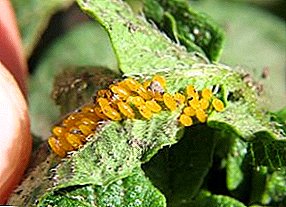 Leaves with eggs are removed and crushed. Beetles and their larvae can be collected in jars and burned or placed in kerosene / saline solution. In any case, simply throwing out bugs and larvae can not, because they will return to your site.
Leaves with eggs are removed and crushed. Beetles and their larvae can be collected in jars and burned or placed in kerosene / saline solution. In any case, simply throwing out bugs and larvae can not, because they will return to your site.
Traps and lures
If you intend to plant a large plot of land with potatoes, then you need to somehow protect it from the beetle. For this you can use homemade trapby placing it around the perimeter of the site.
Important! The trap will work only if there is no wintering beetle on the landing territory.A ditch is dug along the perimeter of the plot with the help of a V-shaped plow. The walls of the moat should be steep (slope not less than 45˚). The depth of the moat is 30 cm, height is 20-50 cm. The bottom of the trench is lined with a black film 130-160 cm wide. The film is tightly pressed to the walls, holes are made every 2-2.5 m to drain water. The earth taken out of the trench is laid on top (like a parapet) and leveled.
The idea is that the Colorado potato beetle (in the spring it cannot fly due to the lack of strength) moves only along the ground. Getting into the trench, he can get out only through the holes. Due to the large amount of moisture in the places of punctures, a fungus develops, which is harmful for the insect.
 Thus, the beetle has 2 options: either die from dehydration within a week, or die from a fungus.
Thus, the beetle has 2 options: either die from dehydration within a week, or die from a fungus.
This is the best way to protect solanaceous crops from the Colorado potato beetle without the use of chemicals. Such a trap will stop about 70-75% of all pests.
If the plot with a small potato, then you can use "dot" bait from potatoes.
To do this, a week before the shoots on the site need to scatter the sliced potato tubers. However, before using the root vegetable should be soaked for a day in a solution of chlorophos.
Hungry beetles pounce on potatoes and after some time die from poison. With the help of such baits, you can destroy the first wave of beetles, which appear before the shoots of potatoes.
Such an operation can be carried out after harvest, when the pest has not yet had time to go to the ground. So you will secure the plot for the next year.
Mulching straw between rows of potatoes
Straw mulching - not the most effective method of dealing with the Colorado potato beetle, but it also takes place, since it performs several functions at once: discourages the beetle, when rotting gives additional nutrients to the culture, it is the "home" for the natural enemies of the Colorado potato beetle and dims the soil, retaining moisture in it.
 The point is that, when breaking the straw, it emits a smell that overlaps the smell of potatoes, and it is difficult for the beetle to find a landing. Thus, the beetle, falling on the site, will take the potato for the culture inedible for him.
The point is that, when breaking the straw, it emits a smell that overlaps the smell of potatoes, and it is difficult for the beetle to find a landing. Thus, the beetle, falling on the site, will take the potato for the culture inedible for him.
Did you know? In 1876, the Colorado potato beetle began its journey with cargo in the hold of a steamboat and successfully crossed the Atlantic Ocean. The first appearance of the pest in Europe is recorded in the port of Leipzig (Germany).
Spraying infusions and decoctions
Continuing the theme of how to deal with the Colorado potato beetle, it is impossible not to note the effectiveness of folk remedies that were used before the invention of strong chemicals. There is a sufficient number of infusions and decoctions that will help if not to exterminate the parasite, then at least to reduce its number or expel it from the site.
Tobacco Infusion
Tobacco against the Colorado potato beetle has been used for a long time. The fact is that nicotine is poison not only for people or animals. The pest is also vulnerable to nicotine, and its entry into the beetle’s body will lead to death.
It is worth remembering that infusion on tobacco can destroy not only the Colorado potato beetle, but also a whole list of harmless or even beneficial insects.
 Therefore, before applying this infusion, you need to think about whether you will destroy the useful fauna and poison the pets that can "try" this infusion. For making infusion You will need to take 500 grams of tobacco, tobacco dust, leaves, or plant stems. All this is ground and dried.
Therefore, before applying this infusion, you need to think about whether you will destroy the useful fauna and poison the pets that can "try" this infusion. For making infusion You will need to take 500 grams of tobacco, tobacco dust, leaves, or plant stems. All this is ground and dried.
Important! It is not recommended to use the so-called "tobacco" from cigarette packs due to the fact that there is no more than 1/3 of real tobacco there, and it does not make sense to water the potatoes with all kinds of chemicals.Next, shredded tobacco need to insist for two days in a large container, adding 10 liters of water. After two days, the solution is diluted with another 10 liters of water and add about 50 g of soap. We are waiting for the soap to dissolve, and we are going to handle the planting of the bowling.
Infusion of poplar leaves
Infusion on poplar leaves rather scares the beetle than destroy it. Therefore, as soon as the effect of processing passes, the Colorado potato beetle may return.
To get started, collect half a bucket of (10-liter) leaves of poplar. The leaves should be green and fresh, as a good infusion should have a catchy smell. A bucket with leaves to the top is filled with water and put on gas. After boiling the leaves are boiled for half an hour and left to infuse for a day.
Next, infusion need to spray the entire planting of potatoes and other solanaceous crops. The smell of the leaves will block the smell of the plants that the beetle needs, and the Colorado will simply “bypass” the site.
Walnut infusion
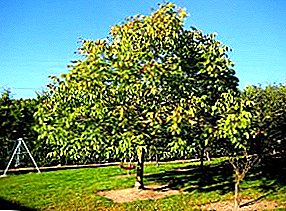 If you grow a walnut (grafted or wild) near your home, then you can make a poison from the Colorado potato beetle with your own hands. For the infusion can be used as the leaves of the nut, and its fruits and shells.
If you grow a walnut (grafted or wild) near your home, then you can make a poison from the Colorado potato beetle with your own hands. For the infusion can be used as the leaves of the nut, and its fruits and shells.
Variant with leaves involves harvesting them in the fall, drying and preserving until spring. As soon as the first shoots of potatoes appear, we begin to prepare the infusion. For infusion will require 2 kg of leaves, which are soaked in 10 liters of water. The readiness of the infusion is indicated by a sharp strong smell of nut leaves. In this case, you need to insist at least 4-5 days. Before using the infusion need to filter 2 times.
Can be used fresh fruit or leavesthat appear in the late spring - early summer. To do this, 2 kg of green fruits (unformed nuts) and green leaves are mixed with 300 g of dry leaves and shells, pour 10 liters of boiling water and infuse for at least 5 days. Infusion before using filtered through cheesecloth.
White acacia infusion
For the preparation of infusion used bark plants. For infusion, you need to cut 1 kg of bark (the crust should be free from rotting, without rot and strong damage), dry it and grind. Next, soak the bark in 10 liters of water and insist about 2-3 days.
The resulting infusion is filtered through burlap and used for the surface treatment of potato bushes.
Important! Infusion need to spray the aboveground part. Simply pouring every bush with infusion is not only useless, but also destructive for the plant.
Infusion of Onion Husk
 Onion Husk used to repel many pests, including the Colorado potato beetle. To prepare the infusion, you need to take half a bucket of dry, clean onion scales, pour boiling water (first put the load on the husk so that it does not float up) and insist for 1-2 days.
Onion Husk used to repel many pests, including the Colorado potato beetle. To prepare the infusion, you need to take half a bucket of dry, clean onion scales, pour boiling water (first put the load on the husk so that it does not float up) and insist for 1-2 days.
After this period, the husk is removed, and the extract is filtered through gauze or burlap. It is impossible to spray potatoes or other nightshade with concentrated infusion, therefore we dilute it 1 to 2 with plain water and can be used to bait a beetle.
Did you know? Onion peel can be embedded in the ground on a plot with potatoes in the autumn to prevent the appearance of the beetle in the spring. To do this, the scales are scattered on the site and dug up to a depth of 30 cm.
Infusion of wormwood
Infusion of wormwood - a popular folk remedy for the Colorado beetles. Wormwood, like onion peel, is used to scare away large numbers of insect pests. Therefore, using the infusion of wormwood, you will not only expel the Colorado, but also get rid of a dozen other parasites.
For the preparation of infusion You will need wormwood and wood ash.
 For 10 liters of hot water take 1 faceted cup of wood ash and 300 g of crushed grass (you can use both dry and fresh wormwood). It is necessary to insist the mixture obtained in about 3-4 hours.
For 10 liters of hot water take 1 faceted cup of wood ash and 300 g of crushed grass (you can use both dry and fresh wormwood). It is necessary to insist the mixture obtained in about 3-4 hours.
Preparing the infusion is recommended immediately before spraying in order to achieve the best effect.
Important! It is necessary to repeat the treatment with infusions every 10-15 days (as necessary). However, the last spraying is carried out no later than 20 days before harvesting.
Burdock infusion
This plant often grows near the road and in this case will be used as a poison for the Colorado potato beetle.
You will need pick several large leaves, chop them up and fill half of a 10-liter bucket. Next, the thread is poured with water and insist for three days. Перед опрыскиванием картофеля настой нужно процедить. 
Important! Infusion is best to spray crops in the evening, since they quickly lose their properties in the sun, and the activity of the beetle, as we know, falls on the night time of the day.
Infusion of honeysuckle high
To prepare the infusion, you can use both dry leaves of the shrub and its shoots.
1 kg of dry leaves or shredded shoots pour 10 liters of water. You need to insist about a day, after which the infusion is filtered and ½ a piece of laundry soap is added. After the soap is dissolved, the infusion is ready for use.
Infusion and broth celandine
 Celandine is often used to control pests of gardens and gardens. In this case, using this plant can be prepared as an infusion, and a decoction to scare the Colorado potato beetle.
Celandine is often used to control pests of gardens and gardens. In this case, using this plant can be prepared as an infusion, and a decoction to scare the Colorado potato beetle.
For infusion take 1.3 kg of celandine (stems, flowers or leaves) and 3 hours insist in 10 liters of hot water. After that, celandine is removed, and 1 l of a 1.5% aqueous solution of potassium chloride (KCl) is added to the infusion itself. Such an infusion not only frightens off the pest with its smell, but also when trying to feast on foliage poisoning the beetle.
To cook the decoction, you need to break the polvedra of celandine, pour cold water over it, bring to a boil and boil for 15 minutes over low heat. The resulting decoction in no case can not be used fresh! It is diluted in a ratio of 1:20 (for 1 l of broth take 20 l of water).
Decoction of dandelions
For the preparation of decoction suitable only fresh plants.
200 g of dandelion grass and 200 g of horsetail leaves are crushed, poured 10 liters of water and boiled for 15 minutes. The broth should be allowed to cool, after which it is immediately ready for use. As in the case of celandine, in its pure form, the decoction can burn the leaves of potatoes or other nightshade, so it must be diluted with water in a ratio of 1 to 20.
Birch tar against beetles
 Birch tar has antimicrobial and antiparasitic properties that are used to bait many parasites that inhabit gardens and orchards. In this case, the tar perfectly destroys the Colorado potato beetle.
Birch tar has antimicrobial and antiparasitic properties that are used to bait many parasites that inhabit gardens and orchards. In this case, the tar perfectly destroys the Colorado potato beetle.
For the preparation of "medicine" take 10 g of tar and 50 g of soap on 10 liters of water. After complete dissolution of the components can be carried out immediately processing plantings.
Did you know? Birch tar is used to destroy the onion fly, cabbage, wireworm and carrot fly. With the help of tar you can scare away mice and hares from fruit and ornamental trees.
Laundry soap with ash
An interesting version of a folk remedy that is used until the larvae appear. After their appearance, unfortunately, the tool is useless.
To prepare the mixture You need to take 1 bar of soap and a two-liter jar of ash. To begin with, dissolve soap in 10 l of water, then add ash and insist for several hours. The resulting suspension is treated with the aerial portion of the potato. 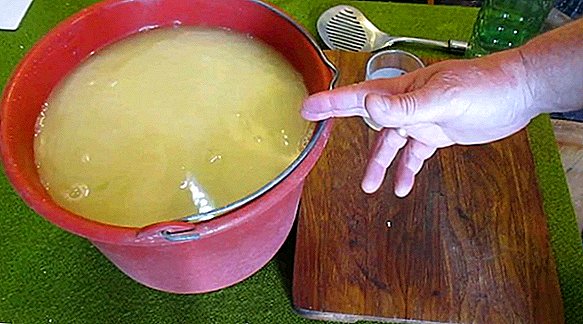
Dusting bushes against Colorado beetles
If the garden is "occupied" by the Colorado potato beetle, then another option on how to get rid of the parasite is dusting beds. Different materials give different effects. Some simply scare away the beetle, others - kill. One way or another, and the effectiveness of dusting has been tested by many gardeners, so we will tell you about several methods of “powdering” potatoes.
Dusting ash
Ash is used not only to fertilize potatoes, but also to protect it. An interesting fact is that the most poisonous for the Colorado potato beetle is birch ash, which is best used for dusting.
It is worth starting with adding ash when planting potatoes. Up to 100 g of ash is put into each well, which not only serves as fertilizer, but also scares beetles hibernating in the ground.
 When the potatoes rise, it is necessary to carry out dusting with ashes every 2 weeks. This should be done early in the morning, when the dew has not descended (ash sticks to the foliage and shoots better, being preserved on them even in windy weather). Use at least 10 kg of ash per hundred. Last dusting is carried out at the end of July.
When the potatoes rise, it is necessary to carry out dusting with ashes every 2 weeks. This should be done early in the morning, when the dew has not descended (ash sticks to the foliage and shoots better, being preserved on them even in windy weather). Use at least 10 kg of ash per hundred. Last dusting is carried out at the end of July.
If everything is done correctly, then in a few days most of the beetles will die on the site.
Dusting cornmeal
The use of corn flour due to its properties: when wet, it increases significantly in volume. Thus, dusting bushes with cornmeal is needed not to scare away, but to destroy the parasites.
Beetle, eating floury potato leaves, after a while simply burst and die. Dusting flour, as well as ash, is carried out after the rain or over the dew, so that the mixture is not blown away by the wind.
Coniferous sawdust against beetles
 Needles due to the allocation of oils has a very unpleasant smell for the beetle. That is why sawdust needles or part of the bark is added when planting potatoes to protect it from the Colorado potato beetle.
Needles due to the allocation of oils has a very unpleasant smell for the beetle. That is why sawdust needles or part of the bark is added when planting potatoes to protect it from the Colorado potato beetle.
Also, sawdust can sprinkle the bushes of potatoes or between the rows during the defeat of the Colorado potato beetle. This method gives good results. If after processing the beetle does not die, it will certainly bypass your site.
We found out that the Colorado potato beetle can be fought without the use of chemistry, since there are many substances that have a detrimental effect on the beetle. If potatoes can transfer the effect of pesticides, then, for example, tomatoes or eggplants will not withstand this, and the future fruit will turn into a repository of poisons. Therefore, the use of folk methods and planting repellent herbs will not only protect the potato from the beetle, but also you from toxic substances.



